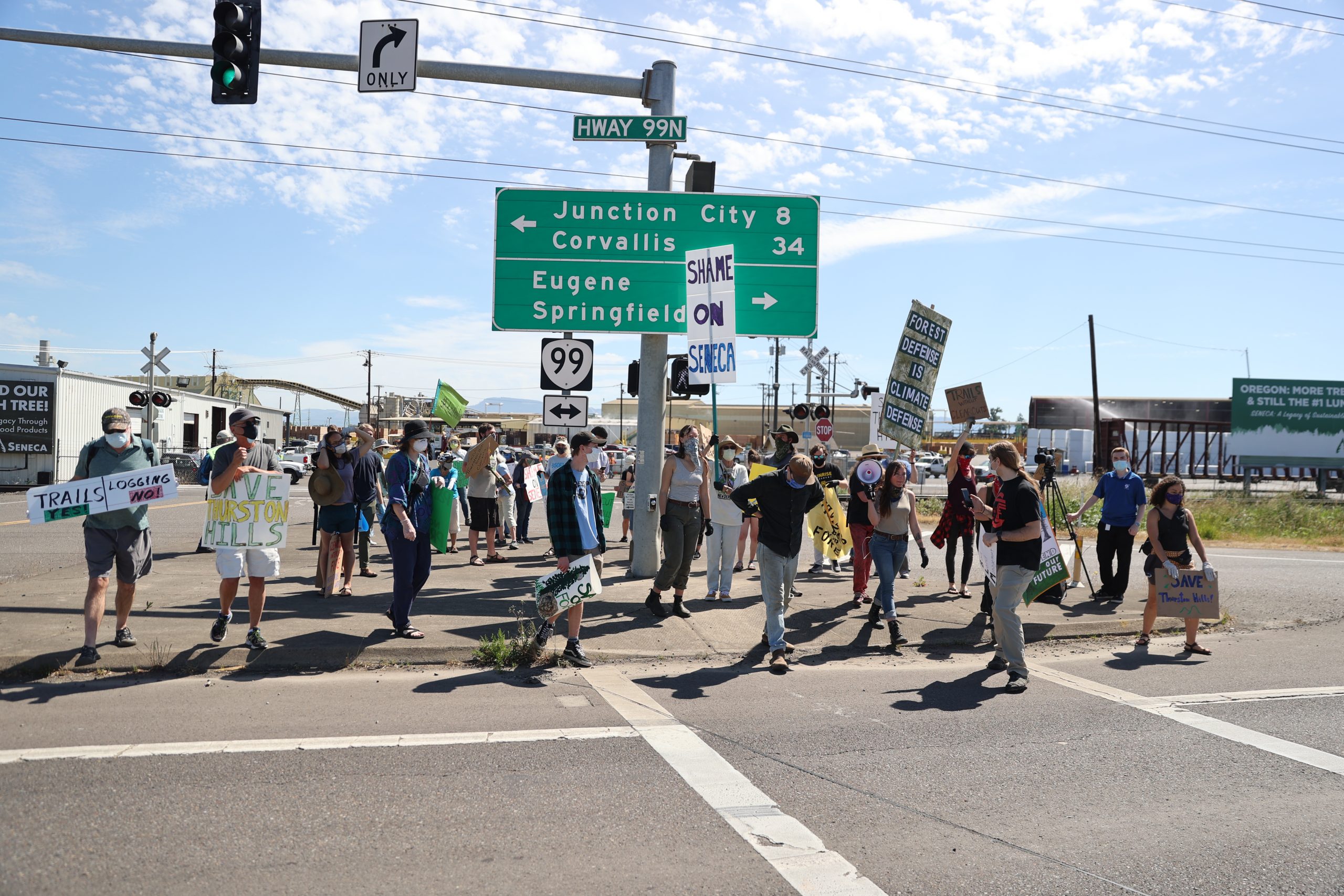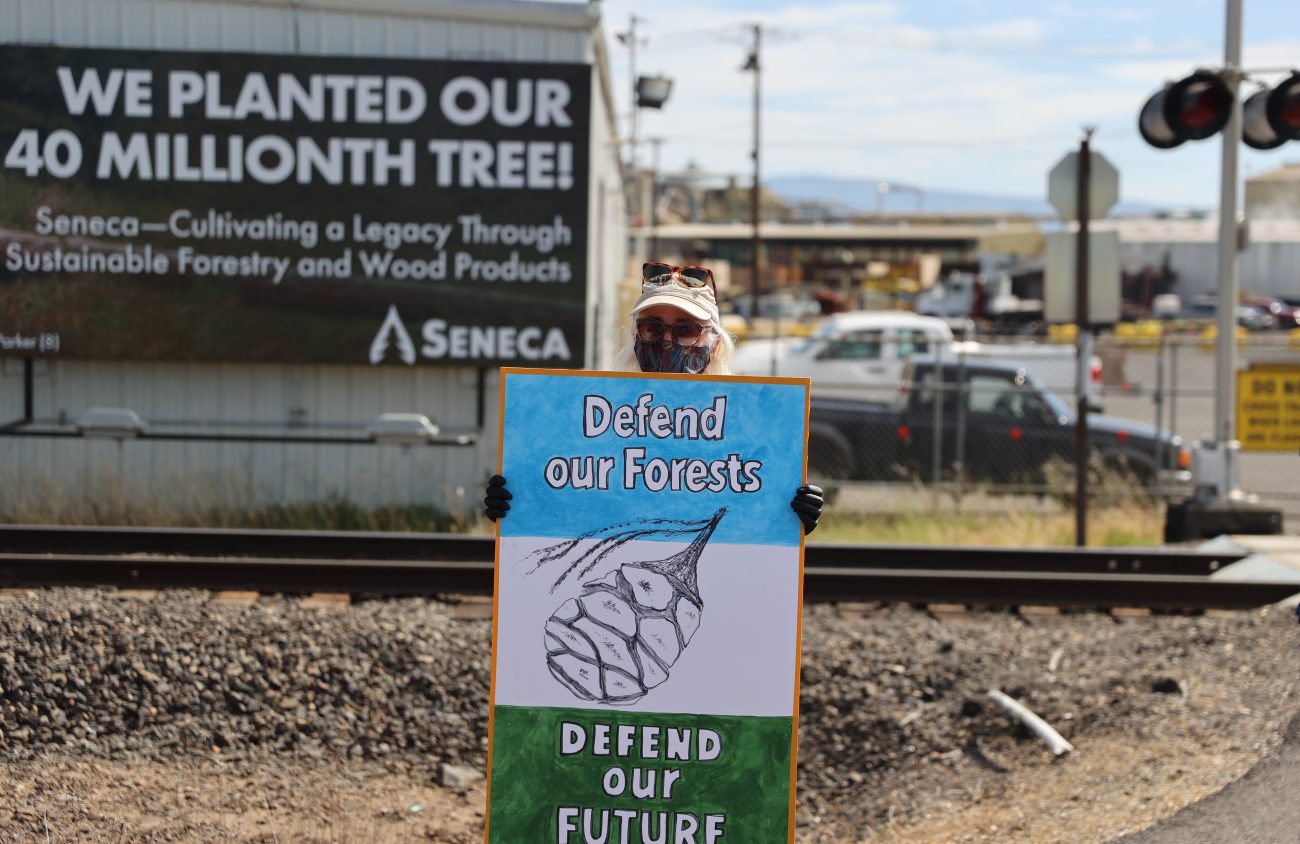Wearing protective masks and gloves — and observing social distancing guidelines — the protesters gathered to raise awareness about the Bureau of Land Management’s decision to allow Seneca to begin logging on its property next to the Thurston Hills.
Sam Krop, who helped organize the protest with Cascadia Wildlands, says that community members have been fighting what they call a clearcut proposal since it was introduced, with varying levels of engagement from elected officials.
We’re super concerned that this clearcut will cause increased fire hazard and that it would clearcut directly over brand new mountain biking trails,” Krop says. “We’re also in the middle of a global pandemic, and we can’t participate and follow all of these bureaucratic processes the same way that we normally would.”
The timber sale is part of BLM’s larger Pedal Power project, which aims to harvest 92 acres of lumber from the Thurston Hills, while adding in 8.5 miles to the Ridgeline Trail system. Both BLM and Seneca have denied that the project is a “clear cut,” maintaining that the lumber sale will only create more trails for the community.
But Thurston Hills residents aren’t so certain, and this isn’t the first time the Pedal Power project has been protested by the public, both in person and via the public comment process. While the plan has continued to be reworked following public scrutiny, the main concerns of activists and Thurston Hills residents remains the same: Increased risk of fire hazards, increased deforestation and a ruined trail system.
As a longtime resident of Thurston Hills, Murray McLeod has kept a close eye on the Pedal Project since 2017. Today, he adorns a homemade black cloth mask and holds a large white sign that says “Save Thurston hills,” written in Oregon Duck colors.
“We’re on a deadline to do something quickly. That’s all we can do right now, is delay the project,” McLeod says. “We think the BLM is being a little devious by using this stay-at-home period to push their agenda through.”
For many of the protesters, it was their first time participating in a public demonstration since the stay-at-home order was issued in March. Eugene native Will Sommer, wearing a tie-dye mask, says he came out to protest to bring attention to an important topic.
“It was nice to be a part of something,” Sommer says. “It was nice to be with people who share a common goal and feel safe. We were still social distancing, and everyone was responsible.”Throughout the years, protests and public comment periods have been one of the only tools community members have for stalling large lumber sales on public land. The protest process through the BLM website allows anyone to submit a comment protesting potential projects.
On May 28, the same day as the Seneca rally, the BLM released a press release detailing plans to uphold the current protest process, claiming that individuals and organizations are using the protest process to delay projects by filing lengthy protests with comments that had already been addressed previously.
“Responding to these protests can be costly to the public in terms of time and other resources, and in many cases offer no value to improve the agency decision,” according to the press release. “It also leads to uncertainty during the auction and award of timber sales, since protest and appeal processes are not available until a decision has been issued.”
According to the press release, the proposed revisions are part of a larger national “wildfire reduction strategy,” headed by President Donald Trump, that hopes to remove barriers preventing the BLM from quickly being able to approve projects and implement policies.
The press release featured approving comments from the logging industry and pro-timber industry politicians, including one from California Congressman Tom McClintock, who said,
“Extremists have hijacked the protest process in order to destroy jobs, drain forest revenues and jeopardize the safety of our mountain communities.”
As the legal director for Cascadia Wildlands, Nick Cady says that the BLM has every intention of limiting the public’s access to the protest process.
“Through these proposed changes, the BLM is attempting to end site-specific review, avoid responding to concerns from the public, and expedite logging that places our communities at risk,” Cady says. “The BLM should be working to increase collaboration with the communities it serves, not trying to avoid it.”

